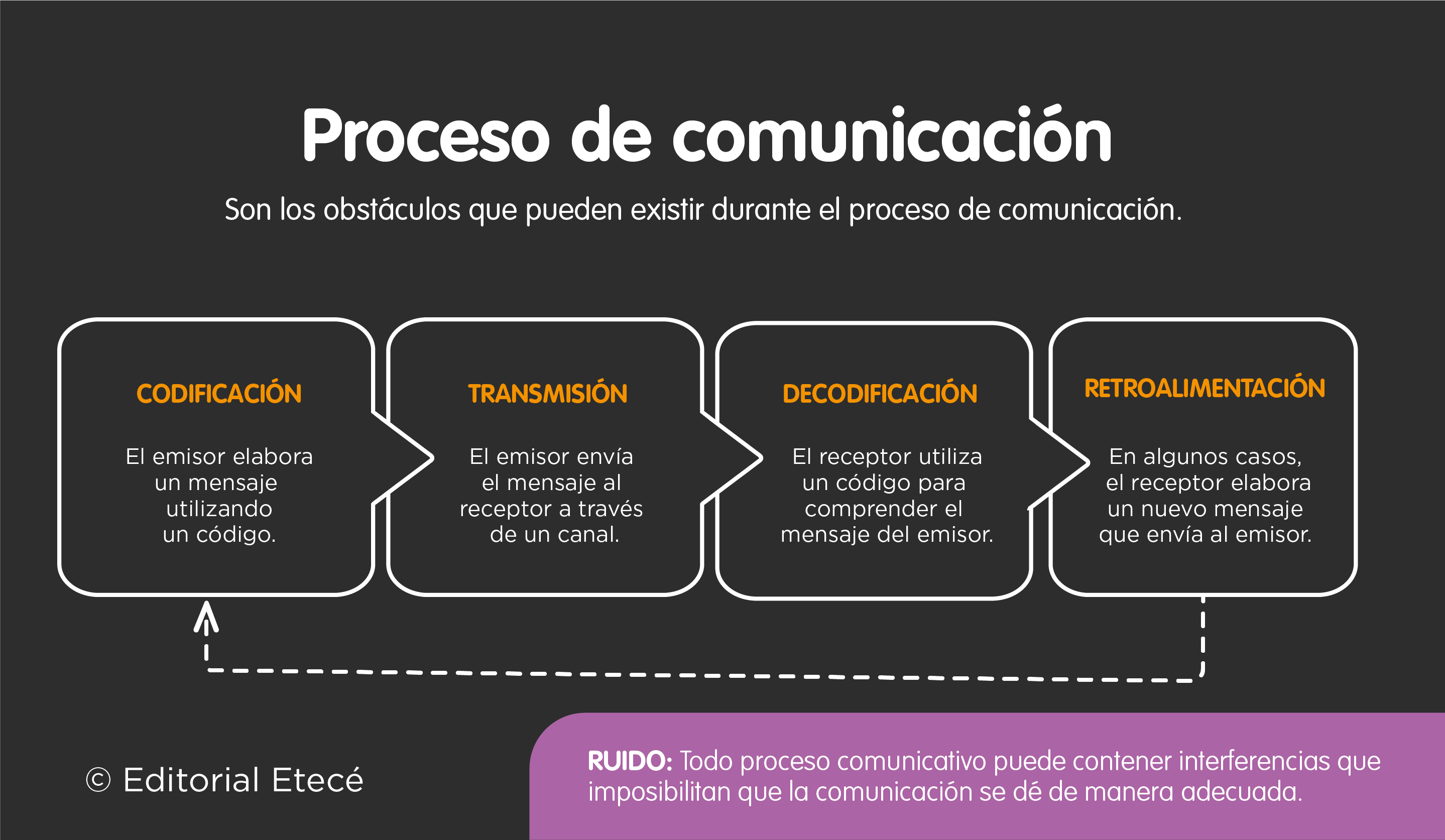We explain what the communication process is and what its stages consist of. In addition, its elements and examples of communicative processes.

What is the communication process?
The communication process, communicative process or communicative act is the effective transmission of a message from a sender to a receiver through a communication channel. That is, it is the complete circuit in which some type of information is exchanged, and it consists of four stages:
- Coding
- Transmission
- Decoding
- Feedback
Communication is a information exchange process that can occur between different living beings. Human beings are the only ones who can do it using language, that is, through words.
However, communication can also occur in other ways. For example, through chemical signals, as microscopic organisms do, or through non-verbal sounds, as birds do with their song.
Depending on how information circulates, the communication process can be unidirectional (information goes in one direction) or bidirectional (information comes and goes).

Frequently asked questions
What is the communication process?
The communication process is the exchange of information that occurs between two or more participants.
What are the stages of the communication process?
The stages of the communication process are encoding, transmission, decoding and feedback.
What are the elements of the communication process?
The elements of the communication process are sender, receiver, message, channel, code and context.
See also: Language functions
Stages of the communication process
The stages or steps of the communication process are encoding, transmission, decoding and, in some cases, feedback.
1. Coding
Coding is the stage in which the sender creates a message using a specific code. The person who begins the communication process thinks about something he wants to convey and then selects different signs of a code to produce a message that expresses his ideas and thoughts to other individuals in the best possible way.
In other words, coding consists of converting an idea into signs that make up a coherent message. For example, when a person wants to say something, he chooses certain words from a language (i.e., signs of a specific code) to encode and express his ideas.
2. Transmission
Transmission is the stage in which The sender sends a message to the receiver through a channel that is, a physical medium that is used to exchange information. For example, when one person speaks, sounds travel through the air and reach another.
The channel must always be open and active for the communication process to be effective.
3. Decoding
Decoding is the stage in which the receiver uses a code to understand the message sent by the sender. When the receiver knows the code of the message, he can understand the meaning of the signs and interpret the information being transmitted.
In other words, decoding consists of transforming signs into ideas. For example, when someone interprets the meaning of the words in a message, they can understand what the other person meant.
4. Feedback
Feedback is a stage that only takes place in some cases, since it consists of the receiver produces and sends a response to the sender. In this step, the roles of sender and receiver are reversed. For example, when a person answers a question.
Not all communication processes have feedback, since there are situations in which the sender and the receiver cannot exchange roles, such as when someone reads a newspaper or watches television.
Noise: Noise is an interference that does not allow the communication process to occur properly. It can affect the channel or the code, and occurs during transmission or decoding, either because the message is not sent, received, or interpreted correctly. For example, when two people are talking on the street and a bus passes by, covering the voice of one of the participants.
Elements of communication

Communication is carried out according to a certain circuit, in which a series of elements intervene:
- Transmitter. It is the participant who begins the communication process. Therefore, elaborate and transmit the message. It represents the starting point of the circuit. For example: a person who starts talking to another or a radio announcer recounting the news of the day.
- Receiver. It is the participant to whom the message is directed, that is, the one who receives and interprets it. Your position is not passive, because you must pay attention to the sender to understand the message. For example: a person listening to another person speak or someone reading a newspaper.
- Message. It is the information that the sender sends to the receiver. For example: an instruction, a conference, a warning or a story of something that happened.
- Channel. It is the physical medium through which communication is established. For example: the sound waves in the air that intervene when a person speaks or the paper that allows written messages to be transmitted.
- Code. It is the set of signs and rules that allow the sender to create a message and the receiver to understand it. It can be linguistic or non-linguistic. For example: a language or symbol systems (such as those used in traffic signs).
- Context. It is the situation in which the communication process occurs. It can influence in different ways, both the message and the process. For example: a store where a customer and a salesperson are talking or a formal work dinner.
Examples of communicative processes
Many everyday situations are examples of communicative processes:
- When a person calls a friend on the phone turns are exchanged to send and receive messages.
- When someone sends a CV by email to a company some recipient is expected to decode the job application.
- When someone reads a book is the recipient of the message that the author wrote. This type of communication is one-way.
- When a cat meows In the kitchen, his owner understands that he is asking for food. This shows that communication does not only occur between beings capable of articulating language.
- When a drop of jam falls on the floor, an ant transmits a chemical message to others to indicate that you have found food.
document.addEventListener(“DOMContentLoaded”, (e) => {
var sliderContainer, slider;
sliderContainer = document.getElementById(‘block_becb86fbbee2fcd6b24ce6eaee24fdfb’);
if (typeof initSlider !== ‘function’) {
console.log(‘Swiper haven\’t been loaded’);
sliderContainer.className += ‘ fw scroll-snap’;
return;
};
options = {
direction: ‘horizontal’,
speed: 1000,
slidesPerView: ‘auto’,
// slidesPerGroup: 1,
centerInsufficientSlides: true,
// centeredSlides:true,
spaceBetween: 15,
breakpoints: {
720: {
// centeredSlides: false,
// slidesPerGroup: 2,
spaceBetween: 25
},
},
pagination: {
el: ‘.swiper-pagination’,
type: ‘bullets’,
clickable: true
},
}
slider = initSlider(sliderContainer, options);
})
References
- Escandell Vidal, MV (2020). Communication. Language, cognition and society. Akal.
- Gavidia Anticona, J. A. (2015). Language and communication. Editions of the U.
- Gómez, FSJ (2016). Communication. Salus, 20(3), 5-6. http://ve.scielo.org
- Jakobson, R. (1974). General linguistics essays. Six Barral.





